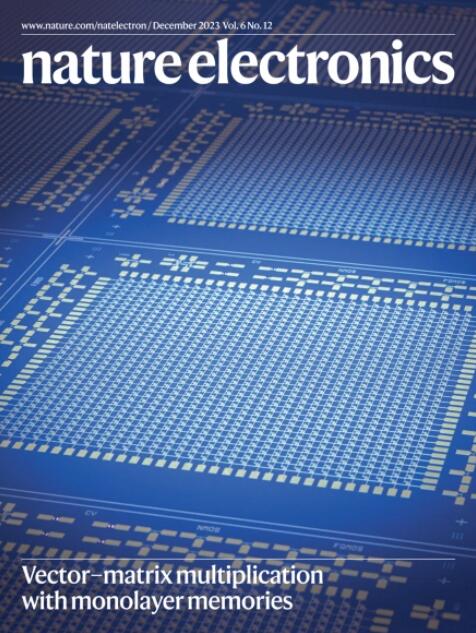作为高κ铁电介质的独立式氧化铪膜集成到二维晶体管中
IF 40.9
1区 工程技术
Q1 ENGINEERING, ELECTRICAL & ELECTRONIC
引用次数: 0
摘要
二维半导体可以作为沟道材料用于具有高栅极控制的小型化晶体管。然而,缺乏既与二维材料兼容又适合集成到完全可扩展的工艺流程中的绝缘体限制了开发。在这里,我们发现独立式氧化铪(Hf0.5Zr0.5O2;HZO膜可以作为高κ介电体与二维半导体集成。HZO膜的厚度从5到40 nm不等,可以转移到二硫化钼(MoS2)上,在场效应晶体管中形成顶栅电介质。20nm厚的HZO膜的介电常数为20.6±0.5,漏电流(1mv cm−1)小于2.6 × 10−6 A cm−2,低于国际半导体技术路线图的要求,并具有典型的铁电行为。采用HZO介质的MoS2晶体管的开/关比为109,在4个数量级的电流范围内,其亚阈值摆幅低于60 mV dec−1。我们使用晶体管创建一个逆变器,逻辑门和一个1位全加法器电路。我们还创建了一个沟道长度为13 nm的MoS2晶体管,其开/关比超过108,亚阈值摆幅为70 mV dec−1。本文章由计算机程序翻译,如有差异,请以英文原文为准。


Integration of freestanding hafnium zirconium oxide membranes into two-dimensional transistors as a high-κ ferroelectric dielectric
Two-dimensional semiconductors could be used as a channel material in miniaturized transistors with high gate control. However, the lack of insulators that are both compatible with two-dimensional materials and suitable for integration into a fully scalable process flow limits development. Here we show that freestanding hafnium zirconium oxide (Hf0.5Zr0.5O2; HZO) membranes can be integrated with two-dimensional semiconductors as a high-κ dielectric. The HZO membranes can be varied in thickness from 5 to 40 nm, and be transferred onto molybdenum disulfide (MoS2) to create the top-gate dielectric in field-effect transistors. A 20-nm-thick HZO membrane exhibits a dielectric constant of 20.6 ± 0.5 and a leakage current (at 1 MV cm−1) of under 2.6 × 10−6 A cm−2, below the requirements of the International Technology Roadmap for Semiconductors, as well as typical ferroelectric behaviour. The MoS2 transistors with HZO dielectric exhibit an on/off ratio of 109 and a subthreshold swing below 60 mV dec−1 across four orders of current. We use the transistors to create an inverter, logic gates and a 1-bit full adder circuit. We also create a MoS2 transistor with a channel length of 13 nm, which exhibits an on/off ratio of over 108 and a subthreshold swing of 70 mV dec−1. Freestanding membranes of hafnium zirconium oxide can be created using pulsed laser deposition method and used as the top-gate dielectric in molybdenum disulfide transistors.
求助全文
通过发布文献求助,成功后即可免费获取论文全文。
去求助
来源期刊

Nature Electronics
Engineering-Electrical and Electronic Engineering
CiteScore
47.50
自引率
2.30%
发文量
159
期刊介绍:
Nature Electronics is a comprehensive journal that publishes both fundamental and applied research in the field of electronics. It encompasses a wide range of topics, including the study of new phenomena and devices, the design and construction of electronic circuits, and the practical applications of electronics. In addition, the journal explores the commercial and industrial aspects of electronics research.
The primary focus of Nature Electronics is on the development of technology and its potential impact on society. The journal incorporates the contributions of scientists, engineers, and industry professionals, offering a platform for their research findings. Moreover, Nature Electronics provides insightful commentary, thorough reviews, and analysis of the key issues that shape the field, as well as the technologies that are reshaping society.
Like all journals within the prestigious Nature brand, Nature Electronics upholds the highest standards of quality. It maintains a dedicated team of professional editors and follows a fair and rigorous peer-review process. The journal also ensures impeccable copy-editing and production, enabling swift publication. Additionally, Nature Electronics prides itself on its editorial independence, ensuring unbiased and impartial reporting.
In summary, Nature Electronics is a leading journal that publishes cutting-edge research in electronics. With its multidisciplinary approach and commitment to excellence, the journal serves as a valuable resource for scientists, engineers, and industry professionals seeking to stay at the forefront of advancements in the field.
 求助内容:
求助内容: 应助结果提醒方式:
应助结果提醒方式:


